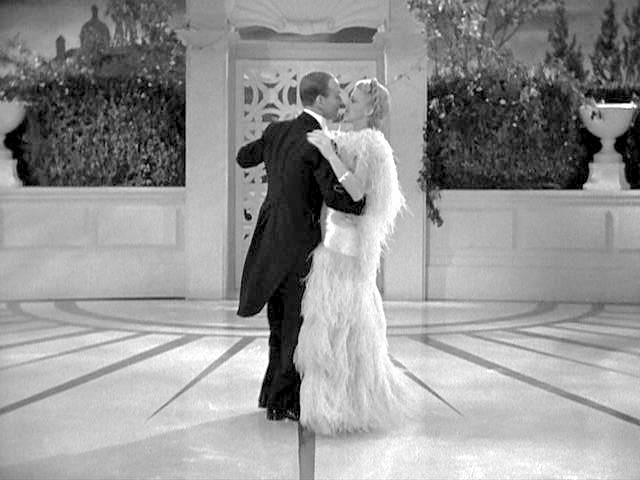← Back to Reviews
in
Astaire and Rogers: Partners in Rhythm
Having seen seven of the ten films that Fred Astaire and Ginger Rogers made together, I was naturally drawn to a 2006 documentary called Astaire and Rogers: Partners in Rhythm, an economic look at cinema's greatest dance team that didn't answer some questions I thought it would, but was definitely worth the watch.

The documentary begins with an overlook at the studio where the films were born, RKO Studios, a tiny studio that was crumbling under the crush of big studios, like MGM, Warner Brothers, and Paramount. The film recounts the beginning of their individual careers, which both began on Broadway. Rogers was actually brought to Hollywood first and made her first big splash in Hollywood with her role in the 1933 classic 42nd Street while Fred was still dancing on Broadway with his sister Adele. At the beginning of the 30's, Fred and Adele were doing a show in England where Adele met and fell in love with an English nobleman and left show business forever. I'm pretty sure this part of Fred's story was partial inspiration for a film Fred did in 1951 called Royal Wedding with Jane Powell.

This documentary then moves into how the pair were brought together totally by accident to play the second leads in a Dolores del Rio movie called Flying Down to Rio. Apparently, Astaire and Rogers made such an impression onscreen together that the ending of the film was changed so that Fred and Ginger have the final scene in the movie instead of del Rio and leading man Gene Raymond. This film then makes a big point of making us understand that being a team was something that neither Fred no Ginger envisioned or planned on. I learned here Fred only agreed to continue making musicals with Ginger after RKO offered him a piece of the profits.

The documentary features commentary from quite a varied group of artists, some who worked with the pair and some who didn't. Commentary is offered by director Peter Bogdanovich, long time Astaire choreographer Hermes Pan, musician Michael Fienstein, dancer Marge Champion, other Astaire leading ladies like Leslie Caron and Joan Leslie, Astaire's daughter, Ava, and, oddly enough, Liza Minnelli, who is billed as an "Astaire friend."

The film also features archival footage of interviews with Ginger Rogers circa 1987, eight years before her death. Watching Ginger talk was fascinating even though a lot of what she said was contradictory to things already said or already considered legend. Ginger vehemently denies that her mother, Lela was a controlling stage mother, like Ethel Gumm was to Judy Garland, though everything we are told says she was. She also mentions in one breath how she loved being paired with Astaire but longed for her own career, but gets very upset when people refer to their films together as "Astaire movies."

This brings me to the most troubling aspect of this documentary...there was no similar footage of Astaire providing his side of the story. I kept waiting to hear Fred's side of things but never did. On the other hand, it shouldn't have really surprised me since for years in interviews, Fred had always dodged the question of who his favorite dance partner was.

Any problems this documentary went by the wayside as these classic dance routines rolled across the screen again. Scenes were provided from the three films I haven't seen that didn't spoil, just pushed them further up my watchlist. There will never be another Astaire and Rogers and fans will be in heaven here.
Having seen seven of the ten films that Fred Astaire and Ginger Rogers made together, I was naturally drawn to a 2006 documentary called Astaire and Rogers: Partners in Rhythm, an economic look at cinema's greatest dance team that didn't answer some questions I thought it would, but was definitely worth the watch.

The documentary begins with an overlook at the studio where the films were born, RKO Studios, a tiny studio that was crumbling under the crush of big studios, like MGM, Warner Brothers, and Paramount. The film recounts the beginning of their individual careers, which both began on Broadway. Rogers was actually brought to Hollywood first and made her first big splash in Hollywood with her role in the 1933 classic 42nd Street while Fred was still dancing on Broadway with his sister Adele. At the beginning of the 30's, Fred and Adele were doing a show in England where Adele met and fell in love with an English nobleman and left show business forever. I'm pretty sure this part of Fred's story was partial inspiration for a film Fred did in 1951 called Royal Wedding with Jane Powell.

This documentary then moves into how the pair were brought together totally by accident to play the second leads in a Dolores del Rio movie called Flying Down to Rio. Apparently, Astaire and Rogers made such an impression onscreen together that the ending of the film was changed so that Fred and Ginger have the final scene in the movie instead of del Rio and leading man Gene Raymond. This film then makes a big point of making us understand that being a team was something that neither Fred no Ginger envisioned or planned on. I learned here Fred only agreed to continue making musicals with Ginger after RKO offered him a piece of the profits.
The documentary features commentary from quite a varied group of artists, some who worked with the pair and some who didn't. Commentary is offered by director Peter Bogdanovich, long time Astaire choreographer Hermes Pan, musician Michael Fienstein, dancer Marge Champion, other Astaire leading ladies like Leslie Caron and Joan Leslie, Astaire's daughter, Ava, and, oddly enough, Liza Minnelli, who is billed as an "Astaire friend."

The film also features archival footage of interviews with Ginger Rogers circa 1987, eight years before her death. Watching Ginger talk was fascinating even though a lot of what she said was contradictory to things already said or already considered legend. Ginger vehemently denies that her mother, Lela was a controlling stage mother, like Ethel Gumm was to Judy Garland, though everything we are told says she was. She also mentions in one breath how she loved being paired with Astaire but longed for her own career, but gets very upset when people refer to their films together as "Astaire movies."

This brings me to the most troubling aspect of this documentary...there was no similar footage of Astaire providing his side of the story. I kept waiting to hear Fred's side of things but never did. On the other hand, it shouldn't have really surprised me since for years in interviews, Fred had always dodged the question of who his favorite dance partner was.

Any problems this documentary went by the wayside as these classic dance routines rolled across the screen again. Scenes were provided from the three films I haven't seen that didn't spoil, just pushed them further up my watchlist. There will never be another Astaire and Rogers and fans will be in heaven here.
